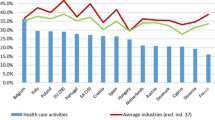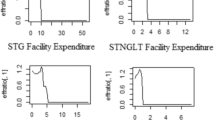Abstract
Due to the rapid market penetration of smartphones and the development of context-aware ubiquitous healthcare services, the demand for ubiquitous healthcare service—to monitor patients’ longitudinal health data continuously and cope with emergency situations—has rapidly increased. Recent developments have suggested that researchers need to provide policy-makers with accessible and reliable information regarding the role of ubiquitous healthcare services. The objective of this study is to investigate the impact of ubiquitous healthcare services on the South Korean economy, using a static input–output approach. We address topics relating to the input–output model, such as the demand-driven model and inter-linkage effects, and the components inherent in an unconventional input–output model, such as the supply-driven model and the Leontief price model. The results indicate that the ubiquitous healthcare industry as a final primary production sector has strong production-inducing effects, weak price ripple effects, and marginal backward and forward linkage effects. It is also found that the industry is closely related to the electric and electronic device sector and the precision machinery sector. This is largely attributable to the convergence characteristics of industries that use wireless telecommunications, as well as those of the medical and measurement device and medical service sectors.
Similar content being viewed by others
References
Blumenthal, D., & Tavenner, M. (2010). The “meaningful use” regulation for Electronic Health Records. The New England Journal of Medicine, 363, 501–504.
Brown, I., & Adams, A. (2007). The ethical challenges of ubiquitous healthcare. International Review of Information Ethics, 8(12/2007), 53–60.
Eng, T. R., Maxfield, A., Patrick, K., Deering, M. J., Ratzan, S. C., & Gustafson, D. H. (1998). Access to health information and support: a public highway or a private road? JAMA, 280(15), 1371–1375.
Field, M. J. (1996). Telemedicine: A Guide to Assessing Telecommunications for Health Care. The National Academies Press.
Gallagher, S. M. (1999). Rethinking access in an information age. Ostomy/Wound Management, 45(9), 12–14.
Hacklin, F. (2007). Management of convergence in innovation: Strategies and capabilities for value creation beyond blurring industry boundaries. Springer Science & Business Media
Hana Institute of Finance (2008). Trend & effects of Ubiquitous healthcare service industry. Industry Report: Series.
Khattak, A. M., Vinh, L. T., Hung, D. V., Truc, P. T. H., Hung, L. X., Guan, D., Pervez, Z., Han, M., Lee, S. Y. & Lee, Y. K. (2010). Context-aware human activity recognition and decision making, e-Health Networking Applications And Services, 12th IEEE international conference
Korea Health Industry Development Institute, (2010). A Study of Industrialization Strategy to Create New Industry of U-Health, 01
Korea Institute for Health and Social Affairs (2011). An analysis of u-Health Service effect. Health and Social Affairs Issue &: Focus No. 79.
Kulkarni, P., & Ozturk, Y. (2011). mPHASiS: mobile patient healthcare and sensor information system. Journal of Network and Computer Applications, 34(1), 402–417.
Kwak, S. J., Yoo, S. H., & Chang, J. I. (2005). The role of the maritime industry in the Korean national economy: an input–output analysis. Marine Policy, 29(4), 371–383.
Lei, D. T. (2000). Industry evolution and competence development: the imperatives of technological convergence. International Journal of Technology Management, 19(7–8), 699–738.
Leontief, W. W., & Leontief, W. (1986). Input-output economics. Oxford University Press on Demand.
Lupianez-Villanueva, F., Hardey, M., Torrent, J., & Fiscapal, P. (2010). The integration of information and communication technology into medical field. International Journal of Medical Informatics, 97, 478–491.
Mayar, W. (2013). The role of telemedicine in the Management Of Stroke Patients And Knowledge Sharing among Health Care providers in Afghanistan(doctoral dissertation, University Of Ottawa).
Miller, R. E., & Blair, P. D. (2009). Input-output analysis: Foundations and extensions. Cambridge University Press.
Seo, H., Ryu, D. H., & Choi, T. (2012). Design and implementation of u-healthcare system for u-wellness. Journal of the Korea Academia-Industrial Cooperation Society, 13(11), 5506–5511.
Smith, R. (1997). The future of healthcare systems. British Medical Journal, 314, 1495–1500.
Sood, S., Mbarika, V., Jugoo, S., Dookhy, R., Doarn, C. R., Prakash, N., & Merrell, R. C. (2007). What is telemedicine? A collection of 104 peer-reviewed perspectives and theoretical underpinnings. Telemedicine and E-Health, 13(5), 573–590.
Steinback, S. R. (2004). Using ready-made regional input-output models to estimate backward-linkage effects of exogenous output shocks. The Review of Regional Studies, 34(1), 57–71.
The Bank of Korea, Input-Output Table (2009), (2011)
US Department of Health and Human Services. (2006). The health consequences of involuntary exposure to tobacco smoke: a report of the surgeon general. Atlanta, GA: US department of health and human services, centers for disease control and prevention, Coordinating center for health promotion, National center for chronic disease prevention and health promotion, Office on smoking and health, 709.
WHO (2003). The World Health Report 2003.
Wu, L., Li, J. Y., & Fu, C. Y. (2011). The adoption of mobile healthcare by hospital's professionals: An integrative perspective. Decision Support Systems, 51(3), 587–596.
Xing, W., Ye, X., & Kui, L. (2011). Measuring convergence of China's ICT industry: An input–output analysis. Telecommunications Policy, 35(4), 301–313.
Yoo, S. H., & Yang, C. Y. (1999). Role of Water Utility in the Korean National Economy. International Journal of Water Resources Development, 15(4).
Yoo, S. H., & Yoo, T. H. (2009). The role of the nuclear power generation in the Korean national economy: An input-output analysis. Progress in Nuclear Energy, 51, 86–92.
Acknowledgments
This work was supported by the Sogang University Research Grant of 2011(201110035).
Author information
Authors and Affiliations
Corresponding author
Rights and permissions
About this article
Cite this article
Kim, Y.J., Kim, C.Y. & Shin, Y.J. The effects of ubiquitous healthcare service on the south Korean Economy: using input–output analysis. Inf Syst Front 19, 1149–1160 (2017). https://doi.org/10.1007/s10796-016-9640-3
Published:
Issue Date:
DOI: https://doi.org/10.1007/s10796-016-9640-3




